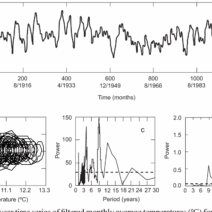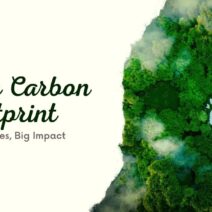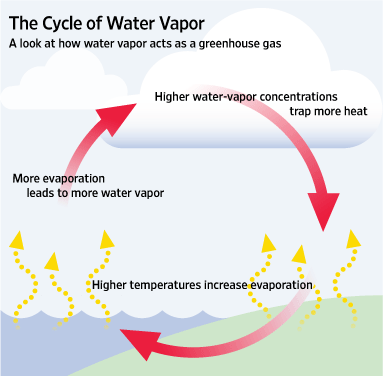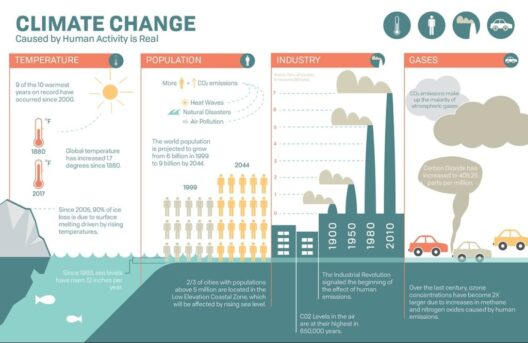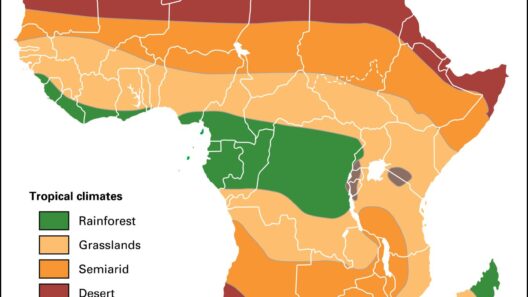Climate feedback loops are phenomena that exacerbate or mitigate the impacts of climate change, acting as mechanisms that can amplify the initial effects of anthropogenic activities. They are a crucial aspect of understanding the complex dynamics of Earth’s climate system. As the climate warms due to greenhouse gas emissions, various natural processes can kick in, leading to additional warming or, conversely, cooling. This interplay of influences can create cascading effects that dramatically alter environmental conditions.
To fully grasp the concept of feedback loops, it is essential first to delineate the distinction between a feedback process and a simple cause-and-effect scenario. Feedback loops can be categorized into two types: positive and negative feedback. Positive feedback loops amplify the initial change, leading to further effects in the same direction, while negative feedback loops counteract and mitigate changes, striving for a state of equilibrium.
One of the most noteworthy examples of a positive feedback loop in the context of climate change is the melting of Arctic sea ice. As temperatures rise, sea ice melts, reducing the planet’s albedo effect—the ability of surfaces to reflect solar radiation. Water, being darker than ice, absorbs more sunlight, which in turn raises ocean temperatures further, leading to even more ice melt. This self-reinforcing cycle serves as a stark illustration of how a slight increase in temperature can lead to significant changes in the environment, subsequently accelerating global warming.
Similarly, the thawing of permafrost is another poignant example of a positive feedback loop. Permafrost, which contains vast amounts of frozen carbon in the form of methane and carbon dioxide, becomes unstable as global temperatures increase. Once thawed, this greenhouse gas is released into the atmosphere, contributing to the greenhouse effect and causing additional warming. Such feedback processes are significant because they can transform a relatively gradual rise in temperature into a rapid, uncontrolled increase in global temperatures over time.
Contrasting with positive feedback, negative feedback mechanisms can play a crucial role in mitigating climate change. One prominent example is the increase in plant growth due to higher carbon dioxide levels. As carbon dioxide concentration increases, photosynthesis becomes more efficient, which can lead to increased biomass and a reduction in atmospheric CO2 levels. Forests, grasslands, and other vegetation types may flourish under these conditions, effectively acting as carbon sinks. However, this response is limited; it does not negate the fact that other feedbacks may overwhelm this positive aspect.
One crucial factor in the realm of climate feedback loops is the interconnectedness of various Earth systems. Different elements, such as cloud cover, ocean currents, and land surface characteristics, all interact with each other in complex ways. For instance, changes in sea surface temperatures can influence weather patterns and, by extension, cloud coverage, which can either trap heat in the atmosphere or reflect sunlight back into space. Such multifaceted interactions make it inherently difficult to predict climate responses accurately.
Another aspect to consider is the role of the ocean in climate feedback loops. The oceans absorb a substantial amount of heat and carbon dioxide produced by human activities. They act as a buffer, moderating temperature fluctuations and storing excess carbon. However, their capacity to absorb these impacts is not infinite. Ocean acidification, the result of increased CO2 absorption, affects marine life and can disrupt ecosystems, leading to less efficient carbon storage. Warming oceans can also result in altered circulation patterns, intensifying weather events and further complicating climate predictions.
In essence, climate feedback loops illustrate the intricate and often precarious balance of Earth’s climate system. Scientists strive to understand these loops to better predict future climate scenarios and societal impacts. However, the complexity and non-linear nature of these feedbacks make precise forecasting exceedingly challenging. Furthermore, the time lags inherent in the climate system mean that some feedbacks may take years, if not decades, to manifest fully; thus, immediate action to reduce emissions is essential.
Moreover, human intervention can also influence these feedback processes. Deforestation, land-use changes, and urbanization can modify local climates, often triggering feedback loops that further exacerbate warming. For instance, removing forests not only releases stored carbon but also reduces local humidity and alters rainfall patterns, which can lead to drier conditions, further impacting ecosystems and human livelihoods.
The fascination surrounding climate feedback loops stems from their profound implications. They serve as a reminder of the interconnectedness between human activity and the environment. The realization that our actions can set off cascading effects within natural systems spurs a sense of responsibility to advocate for sustainable practices. Addressing climate change requires an acute awareness of these feedback loops’ potential consequences and the urgency to mitigate the factors contributing to their acceleration.
In conclusion, climate feedback loops represent a vital concept in understanding how changes in one part of the climate system can spiral into profound consequences, impacting the entire planet. Positive feedback processes can incite rapid change, while negative feedbacks can lend a degree of resilience to the system. A comprehensive understanding of these mechanisms is essential for effective climate policy and action. The challenge lies not only in mitigating emissions but also in recognizing the complexities of our planet’s systems and the interconnected nature of climate change. Each decision made today could influence the balance of these feedback loops, making it imperative to act with foresight and responsibility.
